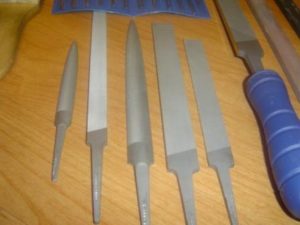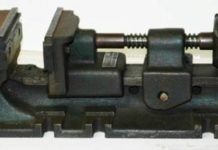Mechanical Files Tool
The widely used hand cutting tool in workshops is the file. It is a hardened piece of high grade steel with slanting rows of teeth. It is used to cut, smooth, or fit metal parts. It is used file or cut softer metals. It consists of the following parts as shown in Fig. The tang is the pointed part, which fitted into the handle. The point is the end opposite the tang. The heel is next to the handle. The safe edge or side of a file is that which has no teeth. It is classified on bases of type or cut of teeth and sectional form.
1. Size of a File
Size of a file is specified by its length. It is the distance from the point to the heel, without the tang. Files for fine work are usually from 100 to 200 mm and those for heavier work from 200 to 450 mm in length.
2. Classification of Files
The files are classified on basis of type of cuts, grade and shapes. These are further sub classified as under
(A) Type of Cut
The most commonly used files according to cuts of teeth are shown in Fig.
(i) Single
(ii) Double and
(iii) Rasp
(B) Grade of Cut
Files are cut with teeth of different grades. Those in general are
(i) Smooth
(ii) Second cut
(iii) Bastered
(iv) Rough
(C) Shape of File
Common shapes of files are having different cross sections, which cover most requirements.
3. Cut or teeth on files
Teeth or cuts of files can be categorized into two groups namely single cut and double cut. In single cut files, the teeth are cut parallel to other across the file at an angle of about 60° to the centre line of the file. Such types of file are named as flats and are widely used on hard metal.
A double-cut file possesses two sets of teeth, the over-cut teeth being cut at about 60° and the up cut at 75 to 80° to the centre line. Single-cut and double-cut files are further classified according to the coarseness or spacing between the rows of the teeth. In descending order of roughness, such files are listed as:
(i) Smooth
(ii) Dead smooth
(iii) Rough
(iv) Bastard
(v) Second cut
(vi) Super smooth
These files are used for finishing general surface work. Both faces of file are double cut and both edges are single cut. Such files are commonly tapered in width and thickness. General classification of files based on shapes or cross sections are shown in Fig. along with their uses are as under:
4. Hand files
Hand files are commonly used for finishing surface work. Both faces of the file are double cut. Either both edges are single cut or one is uncut to provide a safe edge.
5. Flat files
Flat files are generally used for filing flat surfaces in fitting shop.
6. Triangular files
Triangular files are commonly used for filing corners between 60° and 90°. They are double cut on all faces.
7. Square files
Square files are commonly used for filing in corners in jobs. They are double cut on all sides and tapers.
8. Round files
Round files are generally used for opening out holes and rounding inside corners. Rough, bastard, second cut and smooth files under 15 cm in length are single cut.
9. Half round files
These files comprises of flat and half round sides. The flat side of half round file is used for general work and the half round side for filing concave surfaces. These files are double cut on the flat side. The curved side is single cut, smooth or second cut.
10. Knife-edge files
These files are commonly used for cleaning out acute-angled corners. The two faces of these files are double cut, while the edge is single cut. These files are made in sizes from 10 to 20 cm of various shapes and cuts. They are extremely delicate and are used for fine work such as pierced designed in thin metal.
11. Pillar files
These files are used for finishing narrow slots. Both faces are double cut and either both edges are single cut or one is uncut to provide a safe edge of the file.
12. Needle files
Needle files are generally used for filling keys tooth wheels of clocks and other curved surfaces.
13. Mill files
Mill files are commonly used for filing half round recess and gullet of mill saw.
Source A Textbook of Basic Manufacturing Processes and Workshop Technology by Rajender Singh.
















